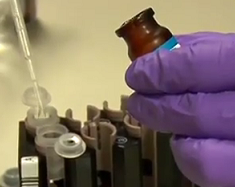In order to meet the demands and requirements for faster and accurate measuring techniques, online systems based on the use of biosensors were developed to offer rapid detection methods. These basically come from the needs that require shorter response time, especially when it comes pollution control that requires fast action plan. In wastewater treatment plants, the main objective of its application is to act as early warning system on the process control monitoring mainly to detect presence of toxicity while in environmental aspects; the biosensor will give an indication on the overall discharged effluent quality. Currently biosensors used for assessing environmental pollution and water quality monitoring mainly involves the use of Biological Recognition Element and its interaction with the Signal Transducers. Generally all these work together to detect the changes not only in chemical properties of the sample but also on the biological constituents as well.
 So far one of the major applications regarding the use of biosensor is when it comes to determination of organic load mainly to replace BOD testing. Since BOD is an important test that represents the amount of organic load in a wastewater sample, the data can provide important information when it comes to plant process control and how well the system is operating. However, the current conventional test method requires at least 5 days period before results are available, and thus online biosensor has been looked upon as a suitable alternative to replace it. The idea behind its application is the use of microorganisms linked to signal transducers that will measure the rate of metabolism that involves in the biodegradation of organic compound and the data will then correlate back to the BOD value. This approach is actually more or less similar to the use on activated sludge biomass and the only difference with this one is on the bioreactor setup. Although this provides only an estimated figure but however, the shorter testing time means that the whole approach could be applied in situations whereby fast results are needed.
So far one of the major applications regarding the use of biosensor is when it comes to determination of organic load mainly to replace BOD testing. Since BOD is an important test that represents the amount of organic load in a wastewater sample, the data can provide important information when it comes to plant process control and how well the system is operating. However, the current conventional test method requires at least 5 days period before results are available, and thus online biosensor has been looked upon as a suitable alternative to replace it. The idea behind its application is the use of microorganisms linked to signal transducers that will measure the rate of metabolism that involves in the biodegradation of organic compound and the data will then correlate back to the BOD value. This approach is actually more or less similar to the use on activated sludge biomass and the only difference with this one is on the bioreactor setup. Although this provides only an estimated figure but however, the shorter testing time means that the whole approach could be applied in situations whereby fast results are needed.For conventional toxicity analysis, use of biological recognition systems including fish and other living organisms has been the common standard approach and many of these test methods are very time consuming and sometimes it can cause broad response mechanism. New biological biosensors nowadays relies mainly on bacterial biochemical pathways such as the oxygen consumption rate which can be effected by the inhibition effect caused by the toxic compounds towards the respiration rate and thus this measurement technique is considered to be more accurate. For example, samples of bacteria from wastewater treatment plant activated sludge process, V. fischeri or some other genetically modified microorganisms have been commonly employed for use in the detection method. These are usually offered in assay form sold by laboratory suppliers and one of the common applications is the use when measuring the effectiveness of a bioremediation program of contaminated water. For on-line monitoring of toxic effluents, optical fibre biosensor can measure the rate of hydrolysis of chemical compound by the microorganisms which is directly proportional to their metabolic rate, thus this gives an indication on the toxicity level.
When it comes to specific chemical detection, particularly pesticides and other non-biodegradable group of contaminants, application of biosensors involve conversion of these pollutants to transform them from being a non-detectable compound to other chemical forms with specific properties that directly inhibit metabolic activity. Other applications include using enzyme-based biosensors that is widely used in analysis and detection of phenolic compounds in wastewater samples.


